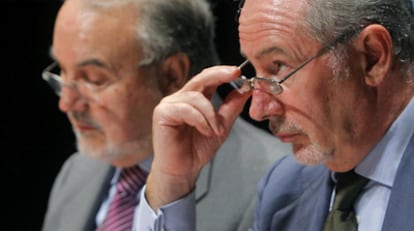How politics broke the bank
Spain's economic supervisor tried to warn of the impending property bubble, but not everybody wanted to hear the message
The future of the Spanish economy depends on its savings banks like never before. A week ago, Moody's took Spain's sovereign rating down a notch from Aa1 to Aa2 due to its banks' recapitalization needs following huge investments in the real estate sector, which crashed in 2007. The country is under close watch due to the possibility that it might need to be rescued like Greece and Ireland before it. The mood is such that Economy Minister Elena Salgado recently warned that it is "extremely urgent and necessary" to recapitalize the banks to clear up the international markets' concerns.
Spain's savings banks (cajas) and commercial banks together hold around 150 billion euros in potentially troublesome real estate assets, or close to 15 percent of GDP. Although comparisons with Ireland are exaggerated, investors are right to fret about the state of the financial sector. This in turn has forced the government to demand an unprecedented level of transparency from cajas and banks, and to raise solvency standards in order to regain credibility. As things stand now, 12 lenders, mostly cajas, need to raise an additional
15.15 billion euros to avoid being nationalized.
So how much of this is the Bank of Spain's fault? The institution attracted a lot of praise for being the only central bank to implement anti-cyclical provisions and forbid the use of risky financial products, such as those related to subprime mortgages. But it turns out that the entire banking sector is suffering from systemic construction-related problems, and not even the Bank's much-vaunted supervision has managed to curb exposure to the real estate risk.
The first question is whether this oversight body offered timely warning about the property time bomb. There is no doubt that it did. "The magnitude of the [property] overvaluation could be in the order of 20 percent," reads a 2003 report that made the front pages of a few newspapers. Even the economy minister at the time, Rodrigo Rato of the Popular Party (PP), was so taken aback that he asked then-Bank of Spain Governor Jaime Caruana for further explanations. Fernando Restoy, one of the authors of the report and currently deputy president of the CNMV, the equivalent of the US' Securities and Exchange Commission, said their analysis was based on a large amount of macroeconomic data and that this was not the first time the agency reached such a conclusion (nor would it be the last).
Weeks later, Minister Rato declared that he did not think there was a real estate bubble in Spain, and that the excessive price of housing "cannot be construed as a bubble like the one technology assets experienced in the year 2000." A few days later, Banco Santander Chairman Emilio Botín confirmed this assessment: "There is no bubble, and in this respect the Bank of Spain report, which I read in depth, has been misinterpreted."
- Political power versus financial clout
This anecdote illustrates the difficult relationship then existing between the government and the central bank governor, or in other words, between political and financial power. This is one of the keys to understanding why the supervisor anticipated the bubble yet did not stop it, or why the question of the cajas' recapitalization was not addressed until the prime minister's La Moncloa office agreed. It is worth remembering that bursting the bubble would have slowed down the economy, and no government wants that, no matter what its political colors. And all this took place even though Bank officials are protected by a law that provides safeguards against political power.
The supervisors of the financial system during the property boom and the current caja crisis were Jaime Caruana (between 2000 and 2006) and his successor Miguel Fernández Ordóñez. Their privileged situation made them key players in the rise and fall of the economy, but did they accurately estimate the real risks threatening the financial system? What further measures could they have undertaken? And if they did not, was it because the measures fell outside their scope or simply because they failed to stand up to the governments that appointed them in the first place?
"Governors, especially after Mariano Rubio, are independent from political power only to a certain extent. You do not get this job through competitive examinations," jokes a former central bank executive. "It is impossible to remain oblivious to the team in office, even more so when banking is such a powerful lobby, with a direct line to La Moncloa." This source also notes that some of the governor's actions must first be approved by the Economy Ministry.
- A free rein for bankers
Between 1994 and 2008, the Spanish economy experienced its greatest bonanza. Following the Barcelona Olympic Games and the Seville Expo, the economy posted a strong recovery partly thanks to a series of tax cuts, especially after Popular Party leader José María Aznar came to power in 1996. The upward trend increased with the single European currency that took effect in January 2000 and a drop in interest rates to levels below inflation, which is basically an invitation to apply for a loan. In 1999 Spain's GDP grew 5.8 percent. Unemployment fell from 22 percent in 1996 to 12 percent in 2003. Meanwhile, the European Central Bank, to which the Spanish supervisor had handed monetary policy, kept interest rates low (in part to encourage Germany's recovery).
Meanwhile, in New York, London and Brussels, central bankers began talking about financial deregulation - that is, eliminating rules and leaving the field wide open for the banking sector. The Basel II Accords were presented as a paradigm allowing each lender to adjust its capital levels according to its own estimation of the risk it was taking on. A few experts even talked about the end of economic cycles as such.
But lenders had to turn the business around because low interest rates did not make for good profits. Bankers found the answer in three different ways: complex and risky financial products that were not used in Spain; an excessive number of branch offices that focused on the real estate sector; and major investments in publicly traded companies, at a time when the stock market seemed like an endless source of profits. The cajas began by specializing in corporate banking, but this opened the door to the world of property developers and builders, a sector they focused on above any other. "It was their worst decision," says José María Martínez, head of the banking division at the CCOO labor union.
The real estate sector fit like a glove on the hand of a financial sector that wanted to grow at any cost. Together, they built a giant with feet of clay: the value of land in Spain ballooned 500 percent between 1997 and 2007.
In the summer of 2000, when Caruana was appointed governor, he already knew that the economy had been overheating since 1995. In his first address to the cajas, on April 18, 2001, he warned about the risks and made four requests: not to abuse industrial investment because it "could be alien to the nature and goals of this type of lender;" to reduce their issue of preferential shares (once an endless source of liquidity); to rein in lending; and to professionalize their boards. At the same time, then-Finance Minister Cristóbal Montoro recommended reducing the political presence of regional governments in the caja sector.
Although Caruana was describing the road that would lead many cajas to the brink of the abyss, at the time these did not share the governor's assessment of the situation and reacted negatively to it. But 10 years after that speech, cajas continue to labor under many of the same problems. In other words, Caruana did nothing to correct them and his successor Ordóñez only did so when it became a national emergency. Two years after that address, in June 2003, with mortgage loans growing at a rate of 20 percent, Caruana again asked banks and cajas to step on the brake.
"The real rise of the cost of housing could have surpassed coherent levels. It is necessary to gradually restrain lending to families and businesses directly involved in real estate, which would prevent housing prices from diverging excessively from their equilibrium values and reduce the possibility of sharper adjustments," he stated. He was talking about a possible bursting of the property bubble.
Nobody paid him any attention: La Caixa increased mortgage lending by 23.4 percent, BBVA by 17 percent, Banco Popular by 43.8 percent, Caja Madrid by 24.9 percent and Santander by 14.9 percent. Bank managers clearly were unable to resist the mirage of easy, neverending profits. "Were we to blame for the bubble?" asks one bank executive today. "We are no doubt responsible for part of it. There were even some bank research departments that anticipated this situation, but it's easy to see it now. Back then, competition was tremendous, and nobody could afford to stop growing or you'd be overtaken in the bank ranking."
Property became the subject of political rows. In 2003 the Socialist José Luis Rodríguez Zapatero (still in the opposition then) attacked the ruling PP over this issue: "It was the PP's policies that created the bubble." In 2004, when the Socialists took office, the story changed. As late as May 2007, with the sector on the verge of collapse, Economy Minister Pedro Solbes stated: "I don't see the construction sector as being at all affected; there is just a slight downturn that will logically result in less demand. Of course it's an issue that requires our attention, but I wouldn't overrate its importance." No doubt, Solbes was thinking ahead to the 2008 general elections.
Did any alarms go off while the boom was underway? They certainly did. "During the bubble, there were two clear danger signs: lenders' rising debt levels compared with their deposit levels, and their focus on the real estate business. In 1998, the financial sector's credit-to-deposit ratio was one-to-one. Eight years later, in 2006, loans represented 50 percent more than deposits. As for loans to developers, they soared from 12 percent of GDP in 2000 to 29 percent in 2005," says Luis Garicano, a professor at the London School of Economics.
Juan José Toribio, professor emeritus at the IESE business school in Madrid, adds a key element to the story:
"These debt levels were made possible by borrowing savings from abroad, a fact that added enormous vulnerability to the Spanish economy. This had never happened before. Spain had the second-highest balance of payments deficit in the world after Iceland, and this should have been a matter of serious concern."
On the positive side, José Carlos Díez, chief economist at Intermoney, notes that Spain's was the only central bank in the world to enforce anti-crisis provisions, forcing lenders to build up a 40-billion-euro safety net and forbidding them from designing the same kind of opaque financial products as their colleagues in other countries, despite protests that Spanish banks were being left behind. That is perhaps why the financial system designed by Caruana was more solid than that of Britain, Germany or the United States.
"If those measures had not been enforced, our fate would be similar to Ireland's," says Díez. "Nevertheless, the supervisor should have been aware that he could not let lenders approve loans for more than 80 percent of the appraisal figure. He could also have limited lending to developers, in which banks took on all the risk."
Garicano adds another thought: "Laws should have been changed to prevent appraisal companies from being owned by lenders. That way, their valuations would have been closer to market prices."
Outside experts also feel that Spain could have done more to prevent the crisis. Nicolas Veron, an analyst at the Bruegel think-tank in Brussels, says that the Bank of Spain "approved a high concentration of real estate risk in some banks. If it had to do it all over again, with the perspective of the crisis, it would be more restrictive."
In hindsight, some Bank officials admit they could and should have taken further action. But they also note that even implementing the anti-cyclical safety net was an uphill struggle. "It created a bitter dispute with the sector and it wore this institution down. Bankers said we were hurting their stock shares because provisions reduced their profits. Perhaps that initiative soothed our consciences, because we thought that [the provisions] would be enough to tide the sector over if the property market crashed," said one source. Another analyst added that enforcing the provisions was "like putting a safety helmet on a Formula 1 driver."
- All warning and no action
Is it enough for a central bank governor to warn about problems yet do nothing to curb them? José Carlos Díez, of Intermoney, thinks not. "The governor is not a market analyst. If he warns about excessive borrowing by businesses and families and the problem is not resolved, he should act," he says. However, he adds, "none of us predicted the magnitude of this crisis, which had a much greater effect than anyone could have imagined."
One of the most far-seeing analyses was made by the Association of Inspectors of the Bank of Spain in May 2006. The report bemoaned "the passive attitude adopted by the managing bodies of the Bank of Spain, with its governor at its head, in the face of unsustainable growth in bank lending during Mr Caruana's term.
"We inspectors at the Bank of Spain do not share the governor's complacent attitude toward the growing accumulation of risk in the banking system derived from the anomalous evolution of the property market since 2000," the report added. Still, even they believed that Spanish lenders were "well capitalized" and that "their solvency is not likely to be compromised even in the more unfavorable scenarios."
In its late 2010 report, the IMF concluded that Spain had experienced the largest real estate bubble in the developed world. Yet this is not what it was saying in May 2006. Under the leadership of Rodrigo Rato (a former economy minister under Aznar), the IMF spent over a year analyzing Spain's economy and financial system, and warned there was a risk of housing prices falling 30 percent over five years in real terms. Yet it concluded that overall, the banking system was in a position to absorb losses without systemic discomfort. It also pointed at the cajas as potential sources of financial instability.
What would have been the consequences of deliberately popping the bubble? Any constraint of credit flows would have hurt GDP and angered politicians. "Considering the high share of GDP taken up by construction, it is undeniable that a decision affecting credit would have had an impact on the economy," says Veron. Luis de Guindos, director of the financial department of Price Waterhouse Coopers, agrees that GDP would have contracted. "There wouldn't have been 3.5-percent growth, but 2.5 percent, and now job destruction would be lower and the financial system would be healthier."
- The Ordóñez experience
If anybody knew exactly what was going on, that was Fernández Ordóñez. In 2003, in two articles published in EL PAÍS, he harshly criticized Rato's legacy and said the former economy minister denied the bubble "out of the fear that any Economy chief feels at the sight of the end of a growth model based on a real estate boom and an explosion of household borrowing." He predicted that the fall in home prices would lead to greater unemployment and a slump in consumption.
What Fernández Ordóñez never expected is that he would personally inherit this legacy. Unexpectedly, in the aftermath of the March 11, 2004 terrorist attacks in Madrid, the Socialist Party rose to power and he was appointed governor of the Bank of Spain. The property boom began cooling off as a result of the international financial crisis, not because Fernández Ordóñez did anything in that direction. The central bank now claims that it would have been too much to sink the real estate sector even further, since it was already collapsing on its own. In his speeches, the governor insisted on the need for families and businesses to reduce their debt levels, and to reform the pension system and labor market, but he made little reference to the property bubble.
His critics say Ordóñez was more concerned about macroeconomic affairs such as pension reform than about bank restructuring, which he took three years to address. The Bank argues that until the government's recent decree forcing cajas to merge, it had no weapons to fight the regional governments. But some observers think there was another, deeper reason. "The Bank of Spain did not want to take issue with the cajas to avoid irritating the PP and the PSOE [Socialist Party]. Ordóñez is a PSOE man. Politics and the fear of legal problems restricted his room for maneuver," said one source.
From the outside, the Bank of Spain looks like a compact stronghold. From the inside, everyone agrees it is a bulwark against the dangers facing the economy and the financial system - yet there are cracks in the walls. "The power lies in government, and increasingly in banking," says one inspector.

Tu suscripción se está usando en otro dispositivo
¿Quieres añadir otro usuario a tu suscripción?
Si continúas leyendo en este dispositivo, no se podrá leer en el otro.
FlechaTu suscripción se está usando en otro dispositivo y solo puedes acceder a EL PAÍS desde un dispositivo a la vez.
Si quieres compartir tu cuenta, cambia tu suscripción a la modalidad Premium, así podrás añadir otro usuario. Cada uno accederá con su propia cuenta de email, lo que os permitirá personalizar vuestra experiencia en EL PAÍS.
¿Tienes una suscripción de empresa? Accede aquí para contratar más cuentas.
En el caso de no saber quién está usando tu cuenta, te recomendamos cambiar tu contraseña aquí.
Si decides continuar compartiendo tu cuenta, este mensaje se mostrará en tu dispositivo y en el de la otra persona que está usando tu cuenta de forma indefinida, afectando a tu experiencia de lectura. Puedes consultar aquí los términos y condiciones de la suscripción digital.








































